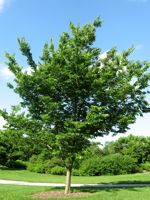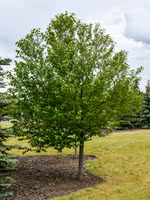Mon-Fri 9am - 5pm Mountain time
Common Hackberry vs Mayday Cherry
Celtis occidentalis
Prunus padus
NOT AVAILABLE THIS SEASON - MIGHT RETURN
The Common Hackberry is a medium-sized deciduous tree that resembles the American Elm but is immune to Dutch Elm Disease. They are versatile and can adapt to a variety of growing conditions.
It produces purple-red, berry-like fruit with a large seed in the center. Both the sweet flesh, which tastes similar to dates, and the crunchy seed are edible. The fruit remains on the tree throughout the winter, offering a valuable food source for birds and other wildlife.
The Common Hackberry can also be a great addition to a pollinator garden. The tree itself is a host for the larvae of several butterfly species and the flowers provide a source of pollen and nectar.
Mayday Cherry is a small deciduous tree known for its early blooming and fragrant white flowers.
A favourite specimen tree on prairie homesteads, Mayday Cherry produces small black berries that are inedible to people but highly desirable to birds.
Common Hackberry Quick Facts
Mayday Cherry Quick Facts
Toxicity: seeds and leaves are toxic if ingested

